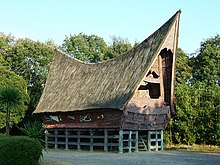Rumah adat
[2] The houses are at the centre of a web of customs, social relations, traditional laws, taboos, myths and religions that bind the villagers together.
[2] The vast majority of Indonesians no longer live in rumah adat, and the numbers have declined rapidly due to economic, technological, and social changes.
[4] The earliest Austronesian structures were communal longhouses on stilts, with steep sloping roofs and heavy gables, as seen in the Batak rumah adat and the Torajan Tongkonan.
[4] The norm is for a post, beam and lintel structural system that take load straight to the ground with either wooden or bamboo walls that are non-load bearing.
[2] Building houses off the ground on stilts serve a number of purposes: it allows breezes to moderate the hot tropical temperatures; it elevates the dwelling above stormwater runoff and mud; it allows houses to be built on rivers and wetland margins; it keeps people, goods and food from dampness and moisture; lifts living quarters above malaria-carrying mosquitos; and reduces the risk of dry rot and termites.
[6] The sharply inclined roof allows the heavy tropical rain to quickly sheet off, and large overhanging eaves keep water out of the house and provide shade in the heat.
This trend dates from the colonial period, with the Dutch generally viewing traditional architecture as unhygienic, with big roofs that sheltered rats.
[8] In parts of the Indies, colonial authorities embarked on vigorous demolition programmes, replacing traditional homes with houses built using Western construction techniques, such as bricks and corrugated iron roofs, fitting sanitary facilities and better ventilation.
In addition, deforestation and population growth meant that the hardwoods were no longer a free resource to be gathered as needed from nearby forests, but instead a too-expensive commodity.
The annual Pasar Gambir for example — a fair held between 1906 and 1942 in Batavia, was known to have gates, stages, towers and pavilions constructed in rumah adat style drawn from all over the archipelago.
The construction of modern concrete framed and brick walled rumah adat has undermine the very characteristic of traditional wooden house, which is its flexibility to absorb shock-waves generated by an earthquake.







